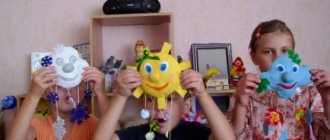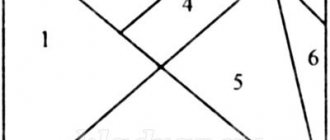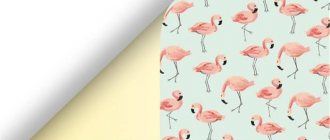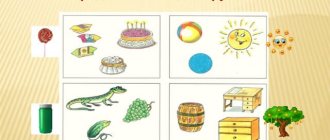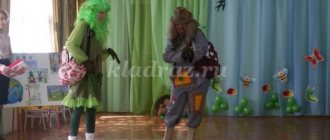Drawing Dandelions in the senior group of kindergarten step by step with photos
Master class on drawing for preschoolers from 5 years old “Dandelions”
Author: Nepomnyashchikh Tatyana Vitalievna teacher MKDOU Kindergarten No. 3 Taishet, Irkutsk region Description of work: designed for children from 5 years old, educators, additional education teachers, loving parents and creative of people. Purpose: for room decoration, gift, can serve as work for an exhibition competition. Goal: Making a drawing using an unconventional technique. Objectives: Continue to introduce children to non-traditional drawing techniques. Improve your ability to work with gouache. Develop children's creative abilities and fine motor skills. To cultivate an aesthetic attitude towards nature in the surrounding world and in art. I suggest you complete the painting “Dandelions”.
Wears a dandelion yellow sundress. When she grows up, she will dress up in a little white dress. Light airy, obedient to the breeze. E. Serova.
A little bit of history. “Everyone loves these simple, cute flowers. But not everyone knows that dandelion is a very useful plant. Pluck a leaf and try it on your tongue. You will immediately feel a special bitter taste. Its bitterness is not harmful. It’s not for nothing that cows and goats look for it in pastures, skipping “sweet” grasses. You can make a delicious salad from the tender spring leaves of dandelions. You just need to pour boiling water over the leaves so that the bitterness goes away. Honey is also made from dandelions. In some countries, this “salad” plant is grown in vegetable gardens, and new varieties are developed. But dandelion is not only a salad plant, but also a medicinal plant. Scientists have found many vitamins in its shiny leaves, which are collected in a rosette.” V. Alexandrov. Necessary materials:
Blue sheet A4 format Gouache Brush No. 3 Jar of water Simple pencil Cereals (semolina) Step-by-step description of the work: Using a simple pencil we draw the stem and leaves of dandelions.
Let's start painting the stems and leaves of dandelions with green gouache.
After we have painted over the stems and leaves of the dandelions, draw the centers with a simple pencil. To do this, draw a circle on white cardboard and cut out the middle.
Apply to the stem.
Lubricate the middle of the dandelion with a thick layer of glue, then sprinkle with semolina.
In the same way we draw the following dandelions. Remove excess semolina.
Let's draw grass.
This is how beautiful dandelions turn out.
Insert the drawing into the frame. I wish you all good luck and creativity!
We recommend watching:
Hand drawing for children 3-7 years old. Dandelions Drawing with Carrot Stamp in Kindergarten. Master class with photos Non-traditional drawing technique for children of the younger group Master class on drawing for children from 7 years old on the topic “Dandelions” with step-by-step photos using the grat technique
Similar articles:
Drawing lesson for children 6-7 years old. Drawing Dandelions
Drawing dandelions in the preparatory group
Painting stones. Ladybug on the lawn
Program tasks
Teach children to enrich the plot with details, draw dandelions using the sprinkling technique. Strengthen your watercolor painting skills. Develop an emotional attitude towards all living things. Cultivate aesthetic taste.
Preliminary work
Reading O. Vysotskaya’s poem “Dandelion”, looking at I. Arkhangelskaya’s illustrations for the collection “Over the River Above the Oka”. Drawing insects. Reading the fairy tale “Winnie the Pooh and All-All-All.” Listening to music.
Visual aids
A painting of dandelions, a toy bear, removable figurines depicting insects, a record.
Handouts for each child
3 circles with a diameter of 5 mm, gouache of yellow and white colors, laid out drop by drop on the palette, watercolor, thin kolinsky brush, bristle brush, simple pencils.
CLASS
Children sit in a semicircle in front of a painting depicting a forest clearing. Educator: Children, imagine that we are in a fairy-tale forest. Do you like walking here? What beautiful and surprising things did you notice? The children answer. Educator: It’s so nice to take a walk in a forest clearing! Music by M. Weinberg “Song about Winnie the Pooh” is played. The teacher feigns surprise. Educator: It seems as if someone is singing. Whose voice do you think this is? Children: This is Winnie the Pooh singing. A Winnie the Pooh doll appears. Educator: Indeed, Winnie the Pooh bear! Winnie the Pooh: Hello, guys! The teacher can speak for Winnie the Pooh, or maybe another, pre-prepared participant in the lesson. Educator: Hello, Winnie the Pooh! Where are you going? Winnie the Pooh: I'm going to see my friend Eeyore for his birthday! I want to give him the most delicate flowers that grow in this clearing - airy and light dandelions. I even learned poems about my bouquet of dandelions. Want to listen? Winnie the Pooh:
The silver dandelion, How wonderfully created it is: Round, round and fluffy, Filled with warm sunshine. On his high leg, rising in the blue, He grows on the path, And in the hollow, and in the grass.
L. Kvitko
Educator: Guys, do you like dandelion? Why do you like him? Have you noticed what kind of leaves it has, what kind of stem it has? Winnie the Pooh: That's why I think dandelions are the best, most delicate flowers. Let me pick this dandelion for Eeyore! A paper butterfly “sits” on a dandelion. Butterfly: Don't touch my house! Winnie the Pooh: Oh! Okay, I won't touch it. Here's another dandelion, I'll pick it! A beetle appears on a dandelion. Beetle: Wow! This is my dandelion! Winnie the Pooh: (gets upset) What is this? Maybe this dandelion is nobody's? He stretches out his paw, but a caterpillar appears on the dandelion. Caterpillar: Shhh. Winnie the Pooh: And there's someone here! (scared) What should I do? I can’t pick flowers in your meadow! And I really want to give Eeyore the donkey dandelions... Where can I get them? The children offer to help the little bear by drawing a bouquet of dandelions. Educator: Children, how can you draw dandelions? And I know another way to draw dandelions. It's called the "spraying" technique. Now I will show you this method. You said that dandelion petals look like a round cap. I'll take a circle cut out of paper, place it on a piece of paper and squirt paint onto it with a stiff brush. Dip the brush into a jar of gouache and pull the hairs with your finger. But not too much so that the paint doesn’t fly in all directions. Under the paper circle, the paper will remain white, and a light colored cloud will form around it. Doesn't it really look like fluff? If you need to draw a lot of dandelions, then put several circles on a sheet of paper. Dandelions are all different heights, so the circles can’t be laid out at the same level. When the dandelion heads are ready, the stem and leaves are painted on with a thin brush. Winnie the Pooh: What a beautiful dandelion! But to make Eeyore even more happy with your drawings, draw insects with beautiful wings and antennae on the flowers, and grass around them. Maybe someone will draw a cheerful stream. Will you draw? Children: Let's draw! The music of Tchaikovsky “Morning” is playing. The children are working. The completed drawings are given to the bear cub so that he can pass them on to the donkey.
Step-by-step instructions for painting a dandelion with paints
A dandelion (a drawing for young children should be simple to execute) can be painted. To depict flowers with fluffy seed caps, it is better to use colored paper, since light paint will be difficult to see on ordinary white sheets.
In this master class, a sheet of blue cardboard was used as a background; the drawing was made in gouache.
Sketch
You need to make a sketch with a hard pencil.
Algorithm of actions:
- 1 thin line to indicate the shape of the stem.
- Draw a circle at the top of the stem. This will be the core of the flower.
- Use short strokes to outline the shape of the seed cap.
- Draw a leaf of a plant.
At this stage there is no need to erase extra lines.
Detailing
Details are drawn with a hard-soft pencil.
Procedure:
- Draw veins on the leaf.
- Add volume to the stem by drawing a parallel next to the intended line.
- Draw the sepals in the form of straight and thick lines.
- Draw small lines from the core of the circle. Draw fluff on top.
- Next to the flower, draw flying seeds with fluff. Let some of them fly, and the other part lie under the flower.
All lines should be thin to make them easier to cover with paint.
Coloring
You will need thin to medium thick brushes.
Procedure:
- Using a medium-thick brush, pick up light green paint and paint over the leaf.
- Paint the stem with dark green color.
- Paint the core of the dandelion with brown paint.
- Wait until the paints dry.
- Take a thin brush, dip it in a dark green color, and draw the veins on the leaf, and also outline it with a zigzag line.
- Circle the sepal.
- Wash the brush, pick up a light green color, and apply a few short strokes along the entire length of the stem on one side.
- Wash the brush thoroughly. Take white paint and circle all the “parachutes” on the seed cap.
- Circle all the flying seeds.
When the white paint has dried, you need to moisten the brush in brown gouache and paint elongated seeds on each individual “parachute”.
Step-by-step instructions for drawing a dandelion with a pencil
The dandelion (the drawing for children over 10 years old should be detailed) should be drawn with sharply sharpened pencils so that the lines are thin and graceful. The picture shows 2 stages of flower development at once: a bud and an inflorescence with seeds. You also need to draw a plant leaf with large teeth.
Sketch
Drawing should begin by marking the contours of the flower. For this you need a hard pencil.
Procedure:
- Draw 1 vertical line from the center of the sheet from bottom to top. It should not be straight, as if drawn with a ruler. On the contrary, you need to make it smooth, slightly curving. This is the base of the dandelion stem. These flowers do not grow straight. Their stems bend from the weight of the inflorescences and take on a curved shape.
- Draw 1 more line nearby. This will be the 2nd stem for another inflorescence. It can be drawn shorter or longer than the first one. It is important that the stems at the bottom come out from 1 point, and at the top they diverge in different directions. The distance between their pinwheels should be such that the flowers drawn next do not intersect with each other.
- Draw a 3rd line on the opposite side. It should be a little shorter than the previous 2. Its top needs to be taken away from others.
- The last line drawn is the middle of the dandelion leaf. Now you need to give it a shape, marking wide teeth on both sides, as well as a sharp top.
- Above 1 line indicate the shape of a fluffy hat with seeds. This should be done with thin, intermittent strokes.
- Above the 2nd line draw the shape of an unopened bud.
A sketch helps to maintain the correct proportions and correctly position all the small details in the drawing. When creating a sketch, you should not put pressure on the pencil. The lead should barely touch the paper and leave almost imperceptible marks.
When all the details are drawn in the picture, the lines made with a hard pencil will need to be erased. If the sketch is rich and clear, it will be difficult to remove it. The result will be a messy drawing.
Detailing
All details must be drawn with a hard-soft pencil.
Procedure:
- Next to each line that imitates the shape of the stem, you need to draw 1 more parallel line. It is important that it follows all the curves. The distance between these lines should be small. They are needed to make the flower stem voluminous.
- Draw sepals on the tops of the stems. They don't have to be straight either. Let the petals bend and twist in different directions. There should be 3-4 petals on 1 sepal.
- Where the shape of the bud is indicated, you need to draw folded leaves, and at the top the protruding ends of the petals.
- There will be a cap with seeds above the 2nd stem, so first you need to draw the core of the flower. It is oval in shape and protrudes above the surface of the sepals.
- Now from this core you need to draw many small lines of different sizes. They should stick out in different directions.
- Using a hard pencil, draw fluff to the top of each line.
- Above the fluffy hat you can depict flying seeds that have calved from the flower. First, draw a line, add fluff on top, and draw an elongated seed below using a soft pencil. The seeds should fly in different directions.
- Draw veins on the leaf of the flower.
The connection of the stems below can be covered with painted grass. Remove all extra lines with an eraser.
Hatching
To make the drawing look three-dimensional, you need to depict shadows. They are applied with strokes using a soft pencil.
Procedure:
- Shade the area under the flower.
- Apply horizontal strokes to 1 side of the stem.
- Mark the shadow under the sepals.
- Darken the middle of the sheet.
Gently rub all the strokes with your fingers. To shade the pencil inside the stem, you can use a cotton swab.
